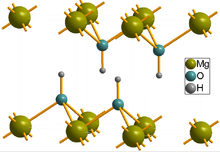Brucite: Difference between revisions
VMS Mosaic (talk | contribs) m minor cleanup |
Cyberbot II (talk | contribs) Rescuing 1 sources. #IABot |
||
| Line 64: | Line 64: | ||
{{reflist}} |
{{reflist}} |
||
{{More footnotes|date=November 2009}} |
{{More footnotes|date=November 2009}} |
||
*{{Cite conference|last=Lee |first=Hyomin |author2=Robert D. Cody |author3=Anita M. Cody |author4=Paul G. Spry |year=2000 |title=Effects of various deicing chemicals on pavement concrete deterioration |booktitle=Mid-Continent Transportation Symposium 2000 Proceedings |accessdate=2009-09-10 |url=http://eco-solutions.net/Effects_of_Various_Deicing_Chemicals.pdf |deadurl=yes |archiveurl=https://web.archive.org/web/20090320061826/http://eco-solutions.net/Effects_of_Various_Deicing_Chemicals.pdf |archivedate=March 20, 2009 }} |
|||
*{{Cite conference |
|||
| last = Lee |
|||
| first = Hyomin |
|||
|author2=Robert D. Cody|author3=Anita M. Cody|author4=Paul G. Spry |
|||
| year = 2000 |
|||
| title = Effects of various deicing chemicals on pavement concrete deterioration |
|||
| booktitle = Mid-Continent Transportation Symposium 2000 Proceedings |
|||
| accessdate = 2009-09-10 |
|||
| url = http://web.archive.org/web/20090320061826/http://eco-solutions.net/Effects_of_Various_Deicing_Chemicals.pdf |
|||
}} |
|||
*{{Cite journal |
*{{Cite journal |
||
| last = Lee |
| last = Lee |
||
Revision as of 16:56, 30 March 2016
| Brucite | |
|---|---|
 | |
| General | |
| Category | Oxide mineral |
| Formula (repeating unit) | Mg(OH)2 |
| Strunz classification | 04.FE.05 |
| Crystal system | Trigonal |
| Space group | Trigonal, hexagonal scalenohedral H-M symbol: (32/m) Space group: P3m1 |
| Unit cell | a = 3.142(1) Å, c = 4.766(2) Å; Z=1 |
| Identification | |
| Color | White, pale green, blue, gray; honey-yellow to brownish red |
| Crystal habit | Tabular crystals; platy or foliated masses and rosettes – fibrous to massive |
| Cleavage | Perfect on {0001} |
| Fracture | Irregular |
| Tenacity | Sectile |
| Mohs scale hardness | 2.5 to 3 |
| Luster | Vitreous to pearly |
| Streak | White |
| Diaphaneity | Transparent |
| Specific gravity | 2.39 to 2.40 |
| Optical properties | Uniaxial (+) |
| Refractive index | nω = 1.56–1.59 nε = 1.58–1.60 |
| Birefringence | 0.02 |
| Other characteristics | Pyroelectric |
| References | [1][2][3] |
Brucite is the mineral form of magnesium hydroxide, with the chemical formula Mg(OH)2. It is a common alteration product of periclase in marble; a low-temperature hydrothermal vein mineral in metamorphosed limestones and chlorite schists; and formed during serpentinization of dunites. Brucite is often found in association with serpentine, calcite, aragonite, dolomite, magnesite, hydromagnesite, artinite, talc and chrysotile.
Notable locations include Wood's Chrome Mine, Cedar Hill Quarry, Lancaster County, Pennsylvania, US.
Discovery

Brucite was first described in 1824 and named for the discoverer, American mineralogist, Archibald Bruce (1777–1818). A fibrous variety of Brucite is called Nemalite. It occurs in fibers or laths, usually elongated along [1010], but sometimes [1120] crystalline directions.
Industrial applications

Brucite is used as a flame retardant because it thermally decomposes to release water in a similar way to aluminium hydroxide and mixtures of huntite and hydromagnesite.[4][5] It also constitutes a significant source of magnesium for industry.
Magnesian attack of cement and concrete
When cement or concrete are exposed to non negligible concentration of Mg2+, e.g. when these materials are left in prolonged contact with sea water or brines, Mg(OH)2 precipitates under the high pH conditions prevailing in the cement porewater. The neoformation of brucite, an expansive material, induces mechanical stress in the hardened cement paste and is responsible for the formation of cracks and fissures in concrete.
The use of dolomite as aggregate in concrete can also cause the magnesian attack and should be avoided.
See also
References
- ^ Brucite on Mindat.org
- ^ Handbook of Mineralogy
- ^ Brucite on Webmineral
- ^ Hollingbery, LA; Hull TR (2010). "The Thermal Decomposition of Huntite and Hydromagnesite - A Review". Thermochimica Acta. 509 (1–2): 1–11. doi:10.1016/j.tca.2010.06.012.
- ^ Hollingbery, LA; Hull TR (2010). "The Fire Retardant Behaviour of Huntite and Hydromagnesite - A Review". Polymer Degradation and Stability. 95 (12): 2213–2225. doi:10.1016/j.polymdegradstab.2010.08.019.
This article includes a list of general references, but it lacks sufficient corresponding inline citations. (November 2009) |
- Lee, Hyomin; Robert D. Cody; Anita M. Cody; Paul G. Spry (2000). "Effects of various deicing chemicals on pavement concrete deterioration" (PDF). Mid-Continent Transportation Symposium 2000 Proceedings. Archived from the original (PDF) on March 20, 2009. Retrieved 2009-09-10.
{{cite conference}}: Unknown parameter|booktitle=ignored (|book-title=suggested) (help); Unknown parameter|deadurl=ignored (|url-status=suggested) (help) - Lee, Hyomin; Robert D. Cody; Anita M. Cody; Paul G. Spry (2002). "Observations on brucite formation and the role of brucite in Iowa highway concrete deterioration". Environmental and Engineering Geoscience. 8 (2): 137–145. doi:10.2113/gseegeosci.8.2.137. Retrieved 2009-09-10.
- Wies aw, W; Kurdowski (September 2004). "The protective layer and decalcification of C-S-H in the mechanism of chloride corrosion of cement paste". Cement and Concrete Research. 34 (9): 1555–1559. doi:10.1016/j.cemconres.2004.03.023.
- Biricik, Hasan; Fevziye Aköz; Fikret Türker; Ilhan Berktay (2000). "Resistance to magnesium sulfate and sodium sulfate attack of mortars containing wheat straw ash". Cement and Concrete Research. 30 (8): 1189–1197. doi:10.1016/S0008-8846(00)00314-8.
